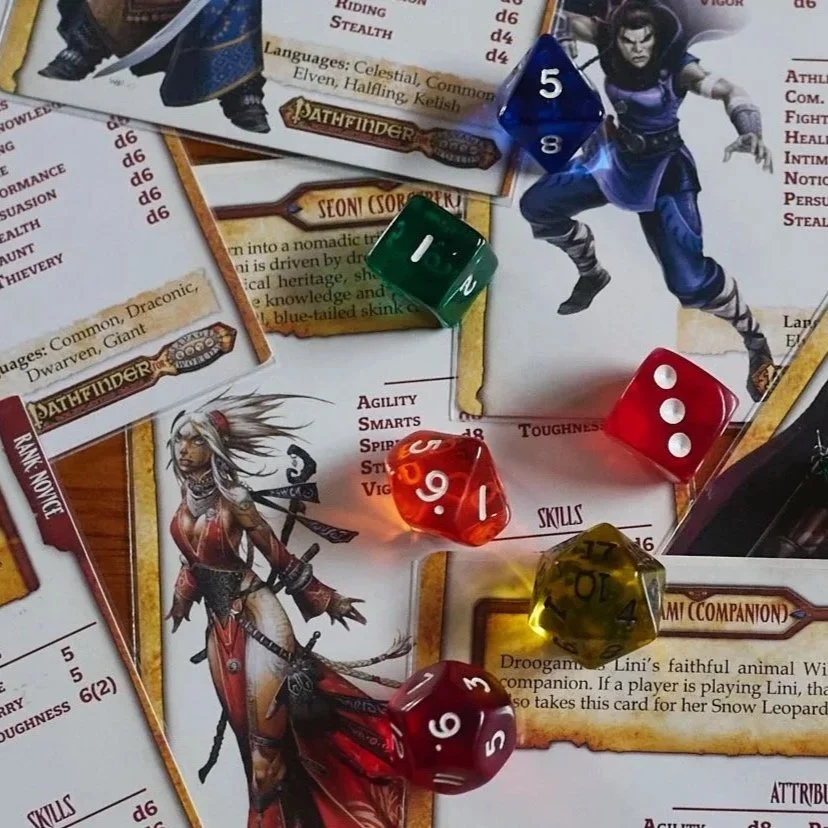The original system that Savage Worlds came from was a pool of dice system and worked well, but the designers felt it could be easier, much easier.
They distilled the pool down to a single dice, with a “wild” dice as the PC/Villain equaliser, to add a curve. At first glance I felt it was too easy and slanted towards weaker characters as the “exploding” mechanism, is rolled was too easy, but I have come to change my mind on that.
The core roll to pass is 4, the Attribute dice range from D4 to D12 and the wild dice is D6 (50/50). Double ones crap out, we will call this a fumble and maximums on the chosen passing dice are an explode (re-roll and add).
The Math;
Rolling an exploding 4 on a d4 is 1/3 easier than rolling a 6 on a d6, but it also has a 75% chance of failing completely (the d6 wild dice is 50%) and the fumble chance is 1 in 24 as opposed to 1 in 36 with 2d6.
Double exploding the d4 is a 1 in 16 chance, 1 in 64 chance of reaching 12 (with 2 raises) and an explode. the 1d4 and 1d6 has a 25% + 50% chance of success, almost all down to the wild dice.
An exploding d6 can match the maximum potential of that d4 triple roll with one maximum (and explode), or a 1 in 36 chance (i.e. almost twice as often) of going again. It has an evens chance of a raise anyway and can reach 3 raises with another roll even without exploding, so more effect and more likely to happen. The 2d6 has 50% + 50% chance of success and 1 in 36 of fumbling.
Going to the extreme end, with a d12 roll, there is a 1 in 72 fumble chance, a 50% + 75% pass chance, less chance of an exploding roll, but a double raise is possible on a natural roll at 1 in 12 with an explode! The fumble drops to negligible (but not improbable, about double the chance of a 2d6 roll), so the good gets exponentially better, the wild dice goes from enabler to safety net.
Three raises (sometimes the practical maximum), can be reached by a d4 or d6 in three rolls, d8 and d10 in two rolls, a d12 can get there in two.
If you cap explode rolls to a single re-roll only for a less swingy game, the d4 can reach one, d6 only two, d8 and above can make three.
If, alternatively, you only allow the Wild dice to explode, there is a 1 in 6 chance of 1 explode with 1-2 raise potential, 1 in 36 of another re-roll, 1 in 216 chance of another and 1 in 1296 of another etc.
I also felt the +1 added after d12 was a patch fix (time the d16 became readily available as a step to the d20), but looking at the math above, it becomes a massive, but still controlled boost. The fumble and explode chance of the raw d12 remains, but the success chance goes up to about 50 + 84% at +1, 50 + 92% at +2 etc until rolls are only used to determine raises and fumble/fails and often only Strength is boosted anyway, meaning only damage dice are boosted.
Simple, clean and as it turns out, effective (seems I substituted a d4 for a d20, my bad).
On the surface, the 25% chance of an exploding d4 seems too good, but the reality is, it is limited in effect, more likely than not to fail and as increments of 4 are needed for raises, it has to explode every roll to make any real difference.
I would argue, the d4 benefit is a good levelling tool at the bottom of the tree for those desperate adventurers who “have a crack”, but are of little other real value and the d12 with a “+” bonus is a good way of capping increases.
The effect of wounds is an interesting side case. Wildcards get three wounds with a -1 to all rolls per wound. Extras or Mooks are down with 1 hit, which if you think about it, ties in with every fight scene in every action ever.
1 wound basically nullifies raw d4’s, meaning they must explode to pass and even the Wild dice is a 66% chance of failing. 2 wounds takes the Wild to 85% fail, the d4 an explode and 2+. 3 wounds means any dice under d8 must now explode to pass and even a d12 is at 50/50 chance.
Wounds then, like the subtle +1 after d12 are a logical way of simulating one of my favourite, but often overlooked issues with RPG combat, where wounds actually simulate shock, blood loss and damage, not just abstract hit points.
Rune Quest first used location hit points so an arm or leg could be crippled or a lucky hit to the head ending it quickly, then Traveller introduced a more abstract but equally effective hits that reduce characteristics model, but it all came with on-the-go math, where SW simply does it with wound counters.
For those who prefer the attritional grind of hit point pools, ask yourself if you are ok with rejecting reality for gamesmanship.
